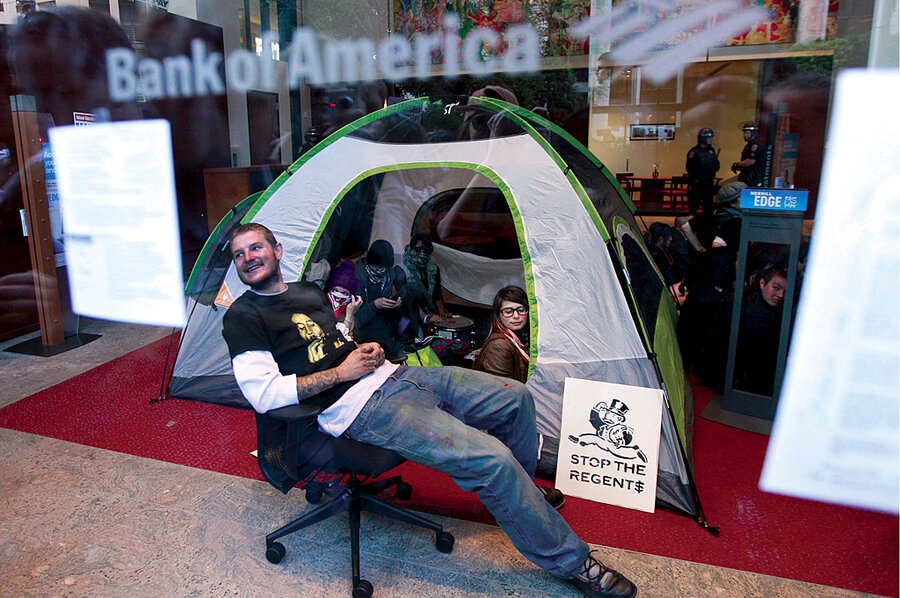Occupy Wall Street? No, divest from it.
Loading...
On one November day, some 40,000 Americans joined a credit union, mostly to protest actions by big corporate banks and to nurture small banks. That protest, dubbed "bank transfer day," is part of a larger movement.
Reminiscent of student divestment movements begun in the 1960s, groups are forming to pressure universities across the United States to move their money from large banks to smaller, community-focused alternatives. If successful, the nascent bank divestment movement could have a lasting effect far beyond the single day of protest.
"Changing your bank account is awesome," says Dan Apfel, executive director of the Responsible Endowments Coalition (REC), which is building a responsible-investment movement with more than 100 colleges and universities. "But getting your school to change their bank has a substantially larger impact."
Many students are asking for the equivalent of 1 percent of their school's endowment to shift toward community banks and investments. Collectively, that would shift nearly $3.5 billion of the combined endowments of more than 450 colleges and universities and support some serious community development.
"As a student at WashU, I've benefited a lot from being in St. Louis," says Molly Gott, an REC student leader at Washington University in St. Louis. "I want to make that relationship reciprocal." She wants to push her school to consider what it can do to alleviate local problems including foreclosures and poverty.
The jury is still out on how much the protest can accomplish.
The REC, which had been laboring in relative obscurity for seven years, got a huge boost this fall when Bank of America announced it would charge some of its debit-card users a $5 monthly fee to replace swipe fees it was losing as a result of federal legislation. Consumers began to organize protests via social media. Fees became a rallying point for the "Occupy" movements around the US. In November, some 500,000 people joined credit unions, just shy of the total for all of 2010, according to the Credit Union National Association. By Nov. 1, all banks, including Bank of America, had backtracked on charging debit-card fees.
But are big banks losing customers?
"Banks ... haven't seen any significant movement whatsoever," says Richard Hunt, president of the Consumer Bankers Association, whose members include Bank of America. "Some people opened accounts at credit unions but didn't close their existing accounts."
"People try to make this a big bank versus small bank issue, but it's much broader than that," he adds. With new federal caps on fees, "everyone in the industry – small banks and credit unions included – are looking at cutting costs and raising revenue."
Student groups are also running into roadblocks. Ian Trupin, a junior at Brown University, helped mobilize 40 students to open community bank accounts following bank transfer day. "More people were interested [in opening accounts]," he says, but were kept from doing so because they shared accounts with parents or were expecting to graduate and move away. He and his peers plan on direct talks with the school next semester.
Moving even a portion of an academic institution's operating budget or endowment can be difficult.
"A number of institutions have endowment gifts that are restricted, which means they can't easily be liquidated," says Ken Redd, of the National Association of College and University Business Officers, based in Washington. Half of all endowment assets are restricted for private universities and colleges, while three-quarters are restricted for public institutions, according to a NACUBO survey. While restrictions don't necessarily state whether funds can be invested in local banks, they could include alumni gifts of stocks that have specified directions on when and how they can be sold and diversified.
Most universities do keep a portion of their endowment liquid, typically 30 to 90 days of their operational budgets. This is the money most student groups are initially pushing to transfer into local banks and credit unions. However, schools often have multiyear contracts with major banks or investment companies to manage their short-term cash. "A school can decide for whatever reason they are going to break their contract, but there's a cost to that," says Mr. Redd.
There are a few cases where universities have moved money to smaller institutions. In 2007, Macalester College moved $500,000 into a community development bank in Minneapolis that funds local businesses in low-income communities. In 2010, Seattle University moved nearly $600,000 into local financial institutions that focus on making small enterprise loans to women and businesses in Seattle and internationally. This past spring, other schools including Fordham, in New York, and Tufts, near Boston, made similar commitments, says Mr. Apfel of REC.
"I think what we're seeing is the infancy of the movement," says Eric Hirsch, a sociology professor at Providence College in Rhode Island, who believes the movement will grow. "That's certainly the way the divestment movement happened."
In the 1960s and '70s Columbia University students were at the forefront of the movement that called for academic institutions to divest from companies doing business in white-minority-ruled South Africa. The idea was revived in the 1980s. In 1986, the US passed its first anti-apartheid legislation that imposed sanctions on South Africa, and many credit the student-led initiative for this measure.
The Occupy movement has added an extra burst of energy to the bank-transfer movement. In response to Occupy Oakland and students' vocal dissatisfaction with the financial crises, the board of trustees for the Peralta Community College District near San Francisco passed a motion late in 2011 to move assets away from large banking institutions.
"I would hope that other government entities, universities, and colleges take some steps to really align their funds with institutions whose values are more rooted in the community," says trustee Abel Guillen.





